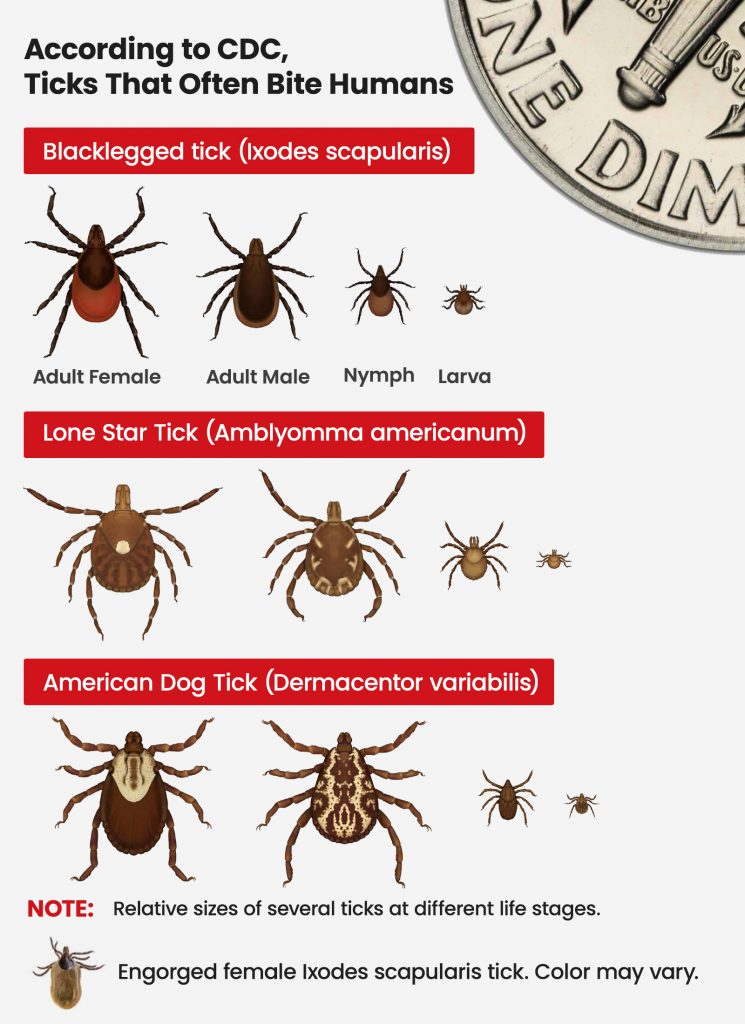Tick Identification Guide
Learn more about common ticks, locations and the diseases they transmit. Stay informed and protect yourself from tick-borne illnesses while exploring the great outdoors!
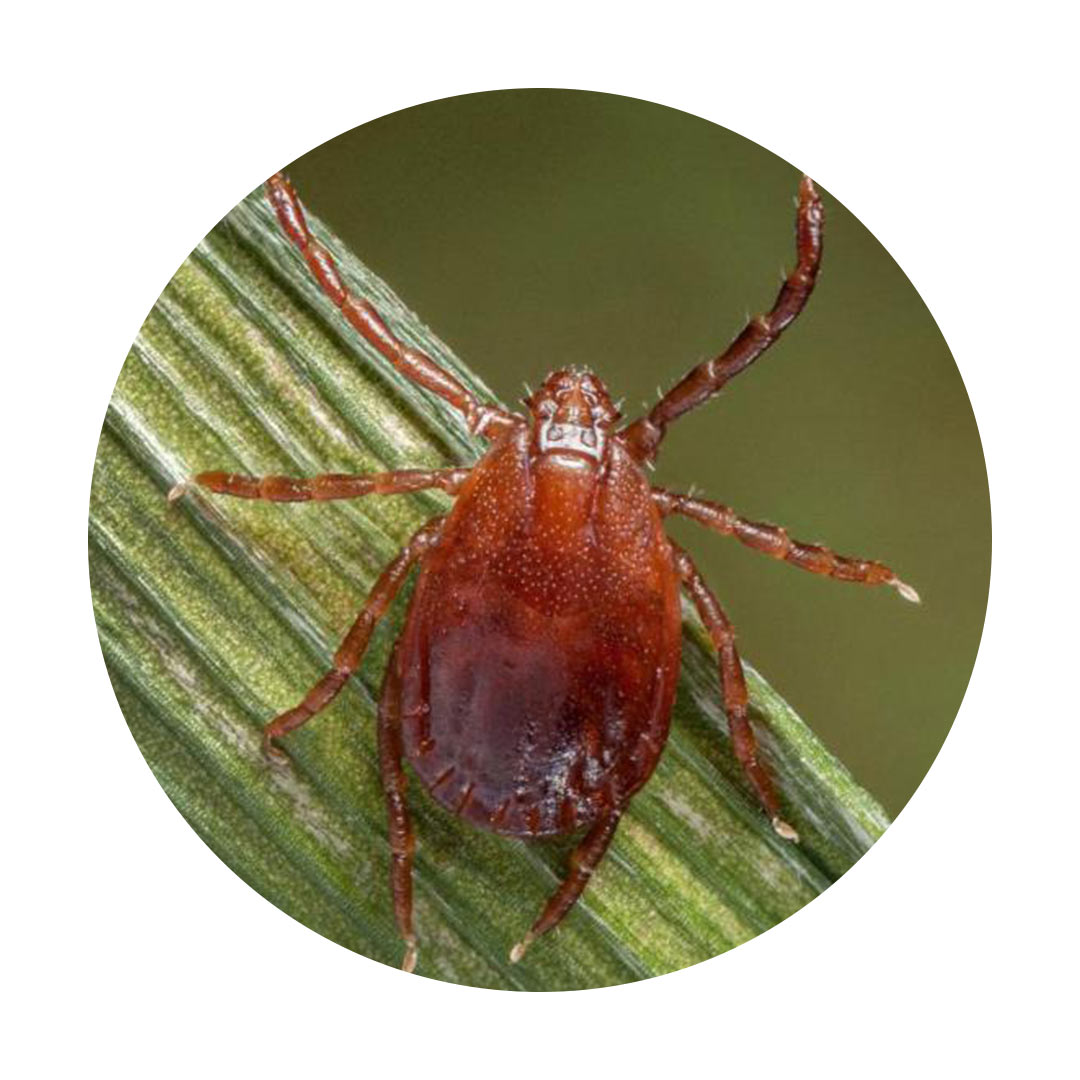
Asian Longhorned Tick (Haemaphysalis longicornis):
Transmits: The Asian Longhorned Tick transmits various diseases, including bacteria and viruses, to animals and humans.
Details: This tick is a small, reddish-brown to dark brown arachnid with distinctive horn-like mouthparts (capitulum). Originally from East Asia, it has spread to the United States, Australia, and other regions. Notably, it can reproduce through parthenogenesis, a unique trait. Found in grassy and wooded areas, it requires careful removal to minimize disease transmission risks. Compared with well-known native ticks (such as the blacklegged tick, lone star tick and American dog tick), the Asian longhorned tick appears to be less attracted to human skin.
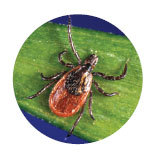
Black-Legged Tick (Ixodes scapularis):
Transmits: Lyme disease, Anaplasmosis, Babesiosis, Powassan virus
Details: The Black-Legged tick, or deer tick, is found in North America. Adults are tiny and
reddish-brown with black legs. They prefer wooded and grassy areas, with nymphs most active
in spring and summer, however adult ticks may be active any time winter temperatures are
above freezing. It transmits Lyme disease, anaplasmosis, and babesiosis, as well as the rare
Powassan virus, causing potentially severe infections
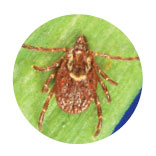
American Dog Tick (Dermacentor variabilis):
Transmits: Rocky Mountain spotted fever, tularemia, tick paralysis
Details: The American Dog tick is widely distributed east of the Rocky Mountains. Females are
brown with a silvery-white shield, males have mottled patterns. Active in warm months, found in
grassy areas and woodlands. The greatest risk of being bitten occurs during spring and
summer. It transmits Rocky Mountain spotted fever, tularemia, and may cause tick paralysis due
to toxins in its saliva.
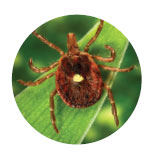
Lone Star Tick (Amblyomma americanum):
Transmits: Ehrlichiosis, Tularemia, Heartland virus, Southern tick-associated rash illness
(STARI)
Details: The Lone Star tick is aggressive and occurs in the southeastern and eastern US.
Females have a distinctive white dot or “lone star” on its back. Found in wooded areas and
grasslands. Transmits Ehrlichiosis, Tularemia, Heartland virus, and may cause Southern tick-
associated rash illness (STARI).
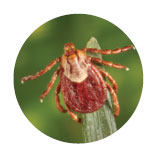
Rocky Mountain Wood Tick (Dermacentor andersoni):
Transmits: Rickettsia rickettsii (Rocky Mountain spotted fever, Colorado tick fever, and
Francisella tularensis (tularemia)
Details: Prevalent in the Rocky Mountains States and southwestern Canada. Females are
brown with silvery-gray markings. Active in spring and early summer. Adult ticks feed primarily
on large mammals, larvae and nymphs feed on small rodents. Adult ticks are primarily
assoicated with pathogen transmission to humans.
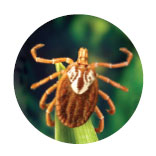
Gulf Coast Tick (Amblyomma maculatum):
Transmits: Rickettsia parkeri (form of a spotted fever), Heartland virus
Details: The Gulf Coast tick occurs in the Gulf and southeastern coastal regions of the US.
Females have a mottled appearance. Found in dense vegetation. Transmits Rickettsia parkeri
and Heartland virus.
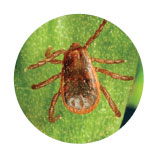
Brown Dog Tick (Rhipicephalus sanguineus):
Transmits: Ehrlichiosis, Babesiosis, Hepatozoonosis
Details: Found worldwide, the Brown Dog tick infests homes and buildings. Adults are reddish-
brown. Commonly found on dogs, but the tick may also bite humans or other mamals. Transmits
Ehrlichiosis, Babesiosis, and Hepatozoonosis, posing a risk to both dogs and humans.
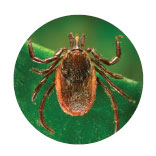
Western Black-Legged Tick (Ixodes pacificus):
Transmits: Anaplasma phagocytophilum (anaplasmosis), B. burgdorferi (Lyme disease), and
very likely B. miyamotoi (Borrelia miyamotoi disease, a form of relapsing fever)
Details: The Western Black-Legged tick is found in the western US. Adults are dark brown with
black legs. They prefer wooded areas with high humidity. Larvae and nymphs often feed on
lizards, birds, and rodents, and adults more commonly feed on deer. Although all life stages bite
humans, nymphs and adult females are more often reported on humans.

Groundhog Tick (Ixodes cookei):
Transmits: Powassan virus (Powassan virus disease)
Details: Also called woodchuck ticks. All life stages feed on a variety of warm-blooded animals,
including groundhogs, skunks, squirrels, raccoons, foxes, weasels, and occasionally people and
domestic animals.
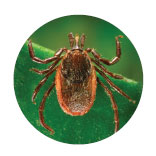
Pacific Coast Tick (Dermacentor occidentalis):
Transmits: Rickettsia species 364D
Details: The Pacific Coast tick is found along the western coast of North America. Adult females
are brown with a whitish-gray pattern. They inhabit grasslands and wooded areas. While it is
less likely to bite humans than other ticks, it has been known to transmit Rickettsia species
364D, which can cause a mild spotted fever illness.

SOFT TICK Ornithodoros spp:
Transmits: Borrelia hermsii, B. turicatae (tick-borne relapsing fever [TBRF])
Details: Throughout the western half of the United States, including Texas.
Humans typically come into contact with soft ticks in rustic cabins. The ticks emerge at night and
feed briefly while people are sleeping. Most people are unaware that they have been bitten. In
Texas, TBRF may be associated with cave exposure.

